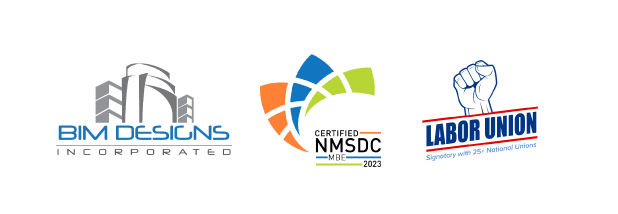
There are a plethora of benefits realized through the use of Building Information Modeling (BIM). It starts with a comprehensive planning process that allows for sharing and collaborating across all stakeholders in a construction project. By modeling building elements in a virtual 3D environment, the pre-construction team can improve coordination across various owners, contractors, architects, and designers through clash detection, better forecast estimates, expenses, and scheduling, and mitigate risks.
BIM also significantly reduces costs, increases productivity, and leads to safer jobs during construction. And the benefits don’t end with a project’s grand opening. Once the project is handed over to facility managers, intelligent virtual elements within models provide feedback and data on building health, allowing for the anticipation of maintenance costs for better ROI in ongoing operations.
Globally, LOD 350 or above is becoming a common requirement. For example, projects in the UK must conform to BIM standards for any public tax-payer supported building project.
Faster build times, fewer reworks, and more control over expenses all add up to better efficiency – saving time and money. Here are three of the key benefits of Building Information Modeling (BIM):
Project Coordination
One of the biggest impacts of BIM is the enhanced project coordination among all stakeholders. As all project collaborators use a single common development environment and compatible formats, everyone shares and benefits from the experience of others on the project. BIM allows everyone to see how even the smallest change can impact the entire project. This makes it easier to estimate costs, workloads, and impacts on timetables.
It also eliminates information siloes that have been a common problem in construction projects for centuries. Keeping information isolated from the group is a recipe for trouble. Entire projects can be placed in jeopardy when the right information isn’t easily accessible or unknown to the people that need it.
This coordination is essential to solving issues before they get to the job site. For example, Building Information Modeling (BIM) automates the clash detection process, which is updated with every change in design. An analysis of BIM Designs, Inc. (BDI) projects shows that projects can have as many as 6,500 clashes. Each of these can be evaluated, grouped down, and assigned to individual MEP trades in a matter of hours.
Scheduling
Besides more accurate crew scheduling, timelines allow for prefabrication. This yields a wealth of benefits. When components are manufactured at a factory or off-site location, the supply chain is better controlled and there are fewer delays due to weather. In fact, when utilizing BIM, there are fewer times construction is placed on hold for another aspect of the project to be completed.
In a case study conducted by McGraw Hill, the construction of an 11-story biomedical facility in Denver, Colorado was completed two months ahead of their anticipated schedule and six months faster than a comparable project that did not utilize BIM.
Prefabricating parts of the construction process speeds up installation and thus the overall construction schedule. When you can build components in a factory setting, you have easier access to the right tools and skilled workforce. This saves you the expense of transporting equipment on-site as well as storing and securing equipment and materials on-site.
Safety
Building Information Modeling (BIM) can reduce time at the worksite by up to 40%. While that saves time and money, it also provides for improved safety. More than 21% of all workplace fatalities happen in the construction industry. According to the Occupational Safety and Health Administration (OSHA), that averages more than 1,000 deaths each year or an average of three per day. Reduced time on site means less risk.
The statistics bear this out: 27% of architects, contractors, and project managers report they saw an improved overall project safety using BIM; 24% of MEP trades agreed, and 37% of owners cited more than a 5% reduction in reportable incidents.
The Building Information Modeling Process
The Building Information Model (BIM) encompasses building geometry, spatial relationships, geographic information, and quantities and properties of building components. From planning to close-out, BIM plays an active role in every phase of the construction project and extends into operations.
Construction projects pass through three major project lifecycles stages:
- Planning and Design
- Construction
- Operations
Building Information Modeling plays an important role in each phase.
In planning and design, BIM can visualize projects, detect clashes, and estimate costs, workflow, and timetables. BIM allows for easy handoff to the construction phase and creates efficiencies with prefabricated design.
During construction, BIM is an important resource for stakeholders to rely on in one consolidated knowledge base.
After close-out, BIM can be used to help manage operations and provide a base for future upgrades or retrofits. Facilities teams can easily utilize BIM to continue to support the building. The spatial and non-spatial data collected during construction can be useful in operations.
Easy access to detailed building information saves time and money. The National Institute of Standards and Technology (NIST) even put a price tag on it. NIST estimates the cost for finding the information after close-out costs 23 cents per square foot. For a typical high-rise averaging around 140,000 square feet, that amounts to $32,300 in savings. With BIM, the information is available at your fingertips with the click of a mouse.

Investing in Building Information Modeling
BIM software requires a significant investment. It also requires computers with a lot of power to manage the intricate calculations and modeling. If you’re doing it on your own, it also means investing in extensive training of your personnel to use it to its full capacity and reap the benefits. It’s a powerful tool that provides strong dividends, but it takes the right tools, training, and experience to make it work for you.
That’s why so many companies hire field-experienced experts like BIM Designs, Inc.(BDI). BDI is a North American, union-signatory preconstruction tech firm, providing turnkey virtual design and construction, software, and BIM solutions to architects, engineers, and contractors.
About BIM Designs, Inc.
BIM Designs Inc. is an agile BIM detailing, modeling, consulting, and coordination service provider. We work closely with architecture, engineering, and construction (AEC) contractors and developers that require experienced journeymen detailers and engineers for Mechanical, Electrical, Plumbing, and Fire Protection (MEPF) modeling, Laser Scanning, and Virtual Design Construction (VDC) services. BIM Designs, Inc. is a signatory with 18 UA and SMART unions in multiple states.
If you need 3D BIM modeling, design, and MEP detailing services, BIM Designs, Inc. (BDI) has the expert tradesmen who know how to precisely design and model your systems. Contact us today for a free estimate or to discuss your project needs.

About the Author
Steve Couch is the Head of Sales and Marketing for BIM Designs, Inc, and is based in Phoenix, AZ. He manages the marketing, sales, and estimating teams to drive revenue and expand client portfolios. An avid international traveler and award-winning public speaker, his experience in public relations, organizational leadership, project management, and communications make him a natural relationship builder, and enables him to build strong community and corporate partnerships.





